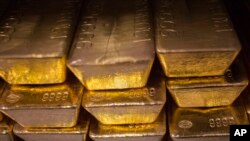As Islamic State faces pressure in its final stronghold in Syria's Deir el-Zour province, the group could be hiding a mountain of gold it smuggled out of other Syrian provinces and neighboring Iraq, a rights group told VOA on Wednesday.
Rami Abdulrahman, head of the U.K.-based Syrian Observatory for Human Rights (SOHR), told VOA that it had confirmation from the ground that IS was holding 40 tons of gold bars in Syria.
"These quantities of gold were held by the IS group since late 2017, specifically in its eastern Syrian pocket" of control, he added.
Rami said his organization's "confirmed reports" indicated the gold, along with millions of dollars, was stockpiled in Deir el-Zour province.
But it was unclear to SOHR whether the gold bars were buried in Baghouz village, hidden in tunnels on the Syria-Iraq border or hidden in areas recently captured by the U.S.-backed Syrian Democratic Forces (SDF).
"This gold was stolen from the Central Bank of Mosul, from the economy in Syria that was under the control of IS, and from the selling of Syrian and Iraqi antiquities, like smuggled antiquities from Palmyra that were sold to smugglers and traders through Turkey," Abdulrahman of SOHR said.
The U.S.-led coalition, which is supporting the SDF fighters in their last push against IS in eastern Syria, said it was not aware of such reports.
The coalition's spokesperson, Col. Sean Ryan, told VOA via email Wednesday that they were investigating the claims.
The Islamic State terror group has been holding firmly to Baghouz since Saturday, when the SDF forces launched their final push to end the jihadists self-proclaimed caliphate. SDF officials estimated there were about 3,000 IS jihadists, mostly foreigners, who were determined to fight to the death.
The SDF says its progress has been slowed by land mines, suicide attacks and the extremists' use of civilians as human shields.
WATCH: A new strategy for Islamic State
Nabil Hassan, the administrator of al-Hol camp in al-Hasakah governorate in Syria's northeast, told VOA that over 23,000 people left their homes last week amid clashes and that more were expected to flee as fighting continued in the region.
The jihadist group's self-styled caliphate once sprawled across large parts of Syria and neighboring Iraq. According to the Paris-based Financial Action Task Force (FATF), the group made millions of dollars through the control of banks, oil and gas fields, taxation, extortion and theft of relics.
In 2014, IS stole nearly $450 million and vast quantities of gold bullion from Mosul's central bank, according the International Business Times.
IS currency
The Syrian group Raqqa Is Being Slaughtered Silently reported in June 2015 that IS went as far as minting its own gold "Islamic dinar" coins. The group then posted photos showing what appeared to be gold sovereigns bearing IS inscriptions.
The U.S.-led coalition over the years has aggressively campaigned to target the group's finances, particularly through shrinking IS territory, conducting airstrikes on IS money reserves and disabling the group's oil fields. U.S. military officials in early 2016 said a U.S. airstrike on an IS cash distribution site in Mosul destroyed millions of dollars.
Iraqi and Kurdish officials say the group has turned to other sources of income that are more difficult to trace.
Iraqi and Kurdish officials told The Washington Post last December that IS leaders had laundered tens of millions of dollars by investing in legitimate businesses throughout the Middle East over the past year. They reported large caches of gold and currency were also buried in the Iraqi desert.
Insurgency
According to Colin Clarke, an expert on terror financing with the Soufan Group, IS could be hiding gold and money reserves to help finance its insurgency actions across the region once its physical caliphate is gone.
"After the territorial caliphate falls, it is possible that small cells of militants will rely on the group's remaining war chest to rebuild core capabilities and recruit new members. Additionally, IS will rely on its money while also pursuing new revenue streams or rejuvenating prior links to trafficking and smuggling," Clarke told VOA.
He said the group's determined fighters had already hoarded weapons to use later.
"What the group has left will be able to last, especially as IS is no longer paying to maintain a state. Its revenues are less, but so are its operating costs," he added.

